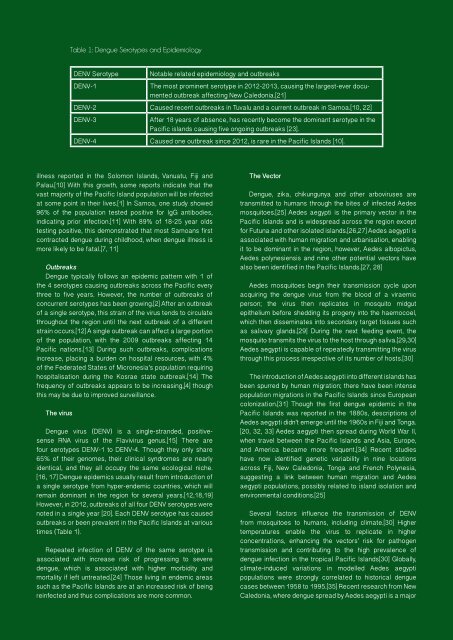Vector Volume 11 Issue 2 - 2017
You also want an ePaper? Increase the reach of your titles
YUMPU automatically turns print PDFs into web optimized ePapers that Google loves.
Table 1: Dengue Serotypes and Epidemiology<br />
DENV Serotype Notable related epidemiology and outbreaks<br />
DENV-1<br />
The most prominent serotype in 2012-2013, causing the largest-ever documented<br />
outbreak affecting New Caledonia.[21]<br />
DENV-2 Caused recent outbreaks in Tuvalu and a current outbreak in Samoa.[10, 22]<br />
DENV-3<br />
After 18 years of absence, has recently become the dominant serotype in the<br />
Pacific islands causing five ongoing outbreaks [23].<br />
DENV-4 Caused one outbreak since 2012, is rare in the Pacific Islands [10].<br />
illness reported in the Solomon Islands, Vanuatu, Fiji and<br />
Palau.[10] With this growth, some reports indicate that the<br />
vast majority of the Pacific Island population will be infected<br />
at some point in their lives.[1] In Samoa, one study showed<br />
96% of the population tested positive for IgG antibodies,<br />
indicating prior infection.[<strong>11</strong>] With 89% of 18-25 year olds<br />
testing positive, this demonstrated that most Samoans first<br />
contracted dengue during childhood, when dengue illness is<br />
more likely to be fatal.[7, <strong>11</strong>]<br />
Outbreaks<br />
Dengue typically follows an epidemic pattern with 1 of<br />
the 4 serotypes causing outbreaks across the Pacific every<br />
three to five years. However, the number of outbreaks of<br />
concurrent serotypes has been growing.[2] After an outbreak<br />
of a single serotype, this strain of the virus tends to circulate<br />
throughout the region until the next outbreak of a different<br />
strain occurs.[12] A single outbreak can affect a large portion<br />
of the population, with the 2009 outbreaks affecting 14<br />
Pacific nations.[13] During such outbreaks, complications<br />
increase, placing a burden on hospital resources, with 4%<br />
of the Federated States of Micronesia’s population requiring<br />
hospitalisation during the Kosrae state outbreak.[14] The<br />
frequency of outbreaks appears to be increasing,[4] though<br />
this may be due to improved surveillance.<br />
The virus<br />
Dengue virus (DENV) is a single-stranded, positivesense<br />
RNA virus of the Flavivirus genus.[15] There are<br />
four serotypes DENV-1 to DENV-4. Though they only share<br />
65% of their genomes, their clinical syndromes are nearly<br />
identical, and they all occupy the same ecological niche.<br />
[16, 17] Dengue epidemics usually result from introduction of<br />
a single serotype from hyper-endemic countries, which will<br />
remain dominant in the region for several years.[12,18,19]<br />
However, in 2012, outbreaks of all four DENV serotypes were<br />
noted in a single year [20]. Each DENV serotype has caused<br />
outbreaks or been prevalent in the Pacific Islands at various<br />
times (Table 1).<br />
Repeated infection of DENV of the same serotype is<br />
associated with increase risk of progressing to severe<br />
dengue, which is associated with higher morbidity and<br />
mortality if left untreated.[24] Those living in endemic areas<br />
such as the Pacific Islands are at an increased risk of being<br />
reinfected and thus complications are more common.<br />
The <strong>Vector</strong><br />
Dengue, zika, chikungunya and other arboviruses are<br />
transmitted to humans through the bites of infected Aedes<br />
mosquitoes.[25] Aedes aegypti is the primary vector in the<br />
Pacific Islands and is widespread across the region except<br />
for Futuna and other isolated islands.[26,27] Aedes aegypti is<br />
associated with human migration and urbanisation, enabling<br />
it to be dominant in the region, however, Aedes albopictus,<br />
Aedes polynesiensis and nine other potential vectors have<br />
also been identified in the Pacific Islands.[27, 28]<br />
Aedes mosquitoes begin their transmission cycle upon<br />
acquiring the dengue virus from the blood of a viraemic<br />
person; the virus then replicates in mosquito midgut<br />
epithelium before shedding its progeny into the haemocoel,<br />
which then disseminates into secondary target tissues such<br />
as salivary glands.[29] During the next feeding event, the<br />
mosquito transmits the virus to the host through saliva.[29,30]<br />
Aedes aegypti is capable of repeatedly transmitting the virus<br />
through this process irrespective of its number of hosts.[30]<br />
The introduction of Aedes aegypti into different islands has<br />
been spurred by human migration; there have been intense<br />
population migrations in the Pacific Islands since European<br />
colonization.[31] Though the first dengue epidemic in the<br />
Pacific Islands was reported in the 1880s, descriptions of<br />
Aedes aegypti didn’t emerge until the 1960s in Fiji and Tonga.<br />
[20, 32, 33] Aedes aegypti then spread during World War II,<br />
when travel between the Pacific Islands and Asia, Europe,<br />
and America became more frequent.[34] Recent studies<br />
have now identified genetic variability in nine locations<br />
across Fiji, New Caledonia, Tonga and French Polynesia,<br />
suggesting a link between human migration and Aedes<br />
aegypti populations, possibly related to island isolation and<br />
environmental conditions.[25]<br />
Several factors influence the transmission of DENV<br />
from mosquitoes to humans, including climate.[30] Higher<br />
temperatures enable the virus to replicate in higher<br />
concentrations, enhancing the vectors’ risk for pathogen<br />
transmission and contributing to the high prevalence of<br />
dengue infection in the tropical Pacific Islands[30] Globally,<br />
climate-induced variations in modelled Aedes aegypti<br />
populations were strongly correlated to historical dengue<br />
cases between 1958 to 1995.[35] Recent research from New<br />
Caledonia, where dengue spread by Aedes aegypti is a major<br />
39

















